|
 Inocybe viscata Inocybe viscata
SynonymsAstrosporina viscata
BiostatusPresent in region - Indigenous. Endemic
Images (click to enlarge)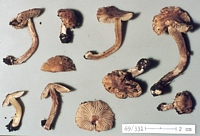
Caption: 69/331: Astrosporina viscata
Owner: Egon Horak | 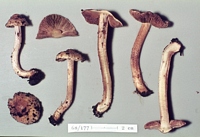
Caption: 68/177: Astrosporina viscata
Owner: Egon Horak | 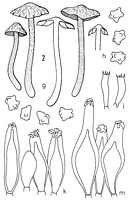
Caption: Astrosporina viscata (type): g, carpophores; h, spores; i, basidia; k, cheilocystidia; m, pleurocystidia. | 
Owner: J.A. Cooper | 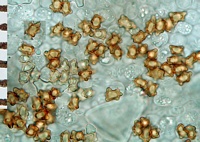
Caption: spores (KOH)
Owner: J.A. Cooper | 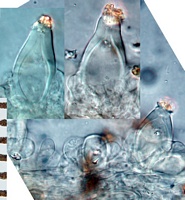
Caption: cheilo and para cystidia
Owner: J.A. Cooper | 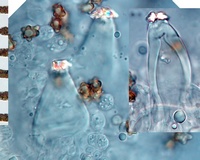
Caption: pleurocystidia
Owner: J.A. Cooper |
Article: Horak, E. (1978) [1977]. Fungi Agaricini Novaezelandiae. VI. Inocybe (Fr.) Fr. and Astrosporina Schroeter. New Zealand Journal of Botany 15(4): 713–747 (http://www.rsnz.org/publish/abstracts.php).
Description: Pileus -35 mm diam., hemispherical when young,
soon campanulate or convex with broad umbo, also becoming expanded with depressed
centre; yellowish brown, beige or avellanous; innately fibrillose, viscid, veil
remnants absent. Lamellae adnexed to sub free, crowded; whitish when young becoming
chocolate or tobacco-brown, dark brown in aged carpophores, edge white, fimbriate.
Stipe 20-75 x 3-6 mm, cylindrical, base rarely slightly swollen; whitish turning
brownish or even dark brown when old, whole length pruinose; solid, dry, cortina
absent, single in groups. Context whitish yellowish, reddish brown in upper
parts of the stipe. Odour none.
Spores 7-9 x 5-6 µm, ovate with wart-like
knobs, brown. Basidia 20-70 x 5-8 µm, 4-spored. Cheilo- and pleurocystidia 30-80
x 10-24 µm, clavate, cylindrical-fusoid, thick-walled, with yellow plasmatic
pigment (in KOH), apex encrusted. Caulocystidia numerous, like pleurocystidia.
Cuticle a cutis of cylindrical hyphae (3-10 ^m diam.), membranes gelatinised,
encrusted with brown pigment. Clamp connections present.
Habitat: On soil in Nothofagus forests (N.
clifforlioides, N. menziesii). New Zealand.
Notes: The viscid pileus, the cylindrical pruinose
stipe, and the small gibbous spores characterise this species. Macroscopically
it could be taken as A. subclavata, but the shape of the cheilo- and
caulocystidia distinctly separate the two taxa.
|